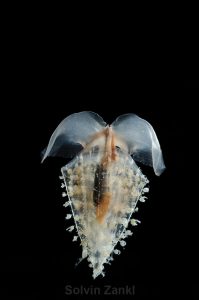Scientists have been monitoring pteropods, more commonly known as “sea butterflies”, as they are excellent indicators of ocean acidification. Now for the first time, researchers have found evidence that these little creatures might be more resilient to climate change than previously thought.

An example of a “sea butterfly”, or pteropod. The thin, carbonate shell is the triangular structure covering the majority of the animal’s body. Image credit: Solvin Zankl, flickr.com
In a paper published January 17th 2018 in the scientific journal Nature Communications, scientists from American and British universities present their surprising latest findings: sea butterflies can thicken their inner shell wall to protect themselves from ocean acidification.
Pteropods are one of many aquatic species under threat of climate change. As the carbon dioxide concentration in our atmospheres increases the oceans become more acidic, which results in shells of marine animals dissolving. This happens because as the water becomes more acidic, the acid breaks down the shell and binds to the carbonate ions that make it up. This process also makes building new shells more difficult and more energy demanding for the animal.
Sea butterflies, which have very delicate carbonate shells, are some of the first organisms to show signs of small, weak, or partially dissolved shells. For this reason, scientists have been monitoring these tiny animals to study the effect of man-made climate change in our world oceans. The video below shows the effects of shell damage on these animal’s abilities to swim.
Video by Dr. Nina Bednarsek. Published on Youtube by NOOA.
In this study, researchers collected pteropod samples from the Fram Strait with damaged shells. The Fram Strait lies in the northern Atlantic, between Greenland and Europe. The samples were then taken back to a lab and analysed using top-notch imaging technology, such as scanning electron microscopes and CT scans; both capable of producing high quality images of very small objects. These images revealed a range of shell damage, all with varying degrees of repair.
In particular, these animals seem capable of secreting material from the inside. This patches up the inner shell to prevent themselves from becoming exposed to predators. While this repair mechanism likely comes with an increased energy and metabolic requirement, it is promising evidence that these animals are more adaptable to climate change than previously estimated.
What does this mean for our current understanding of climate change and its effects? Although it shows nature’s impressive adaptability, it certainly highlights how little we know about our oceans and our long-term effects on it.
– Ana Brunner
References:
GAZEAU, F., PARKER, L., COMEAU, S., GATTUSO, J., O’CONNOR, W., MARTIN, S., PÖRTNER, H. and ROSS, P., 2013a. Impacts of ocean acidification on marine shelled molluscs. Marine Biology, 160(8), pp. 2207-2245.
PECK, V.L., OAKES, R.L., HARPER, E.M., MANNO, C. and TARLING, G.A., 2018a. Pteropods counter mechanical damage and dissolution through extensive shell repair. Nature Communications, 9(1), pp. 264.
